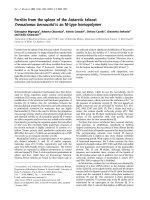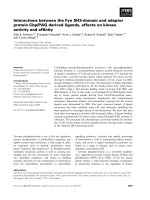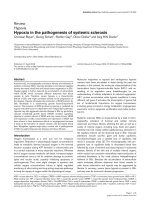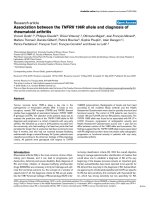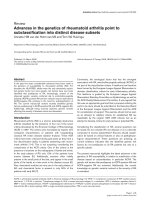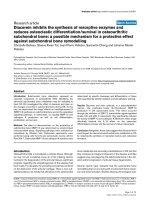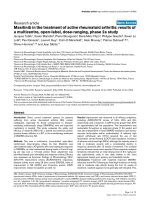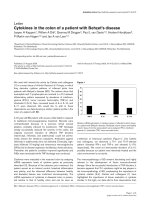Báo cáo y học: "Filtering out the noise: evaluating the impact of noise and sound reduction strategies on sleep quality for ICU patients" ppt
Bạn đang xem bản rút gọn của tài liệu. Xem và tải ngay bản đầy đủ của tài liệu tại đây (41.52 KB, 2 trang )
Available online />Page 1 of 2
(page number not for citation purposes)
Abstract
The review article by Xie and colleagues examines the impact of
noise and noise reduction strategies on sleep quality for critically ill
patients. Evaluating the impact of noise on sleep quality is
challenging, as it must be measured relative to other factors that
may be more or less disruptive to patients’ sleep. Such factors may
be difficult for patients, observers, and polysomnogram interpreters
to identify, due to our limited understanding of the causes of sleep
disruption in the critically ill, as well as the challenges in recording
and quantifying sleep stages and sleep fragmentation in the
intensive care unit. Furthermore, most research in this field has
focused on noise level, whereas acousticians typically evaluate
additional parameters such as noise spectrum and reverberation
time. The authors highlight the disparate results and limitations of
existing studies, including the lack of attention to other acoustic
parameters besides sound level, and the combined effects of
different sleep disturbing factors.
In the previous issue of Critical Care, the review by Xie and
colleagues aims to answer the following questions [1]. Is
noise the most disruptive factor to sleep for intensive care
unit (ICU) patients? How effective are noise reduction
strategies at decreasing sleep disturbance in ICUs? These
are not simple questions to answer. Indeed, the medical
literature appears to give conflicting results: of 11 original
articles reviewed, five studies assert that noise is the most
significant cause of sleep disturbance whereas six other
papers suggest that noise is responsible for only a small
proportion of sleep disruptions. Similarly, studies examining
the effectiveness of noise reduction strategies suggest
variable outcomes, with relative improvements in sleep
ranging from 10 to 68%. What factors account for such
discrepancies amongst studies asking similarly focused
questions?
First, the impact of noise must be weighed relative to other
factors that may be more or less disruptive to patients’ sleep.
But how can we determine the relative significance of noise
when we do not fully understand or cannot accurately
measure all of the factors that may share responsibility for the
sleep disturbance? In a seminal work in this field, Gabor and
coworkers found that noise and patient-care activities
accounted for less than 30% of arousals and awakenings,
while the cause of the remaining 70% of sleep disruptions
remained unidentified [2].
Second, these studies measured similar outcomes from
differing perspectives: those of the patient, of the bedside
observer, and of the sleep specialist. Each of these
perspectives is different, and subject to its own inherent
biases. Questionnaires rely on patients to accurately recall
and identify events from their ICU stay. Although it is clearly
valuable to obtain information regarding patients’ perceptions
and experiences, it may be difficult for healthy individuals, let
alone critically ill patients, to identify all factors that disrupted
their sleep. Furthermore, patients may be more apt to recall
experiences that fall within a previously established frame of
reference. Most people have experienced sleep disruption
due to a noisy environment at some point in their lives;
therefore, patients may be more likely to attribute poor-quality
sleep to noise in the ICU rather than other factors they might
be unaware of, such as patient–ventilator asynchrony or the
severity of their illness [3,4].
An alternate approach to surveying patients is to have an
independent observer at the bedside to assess and quantify
noises and occurrences that arouse the patient from sleep.
Commentary
Filtering out the noise: evaluating the impact of noise and sound
reduction strategies on sleep quality for ICU patients
Karen J Bosma
1
and V Marco Ranieri
2
1
Department of Medicine, Divisions of Respirology and Critical Care Medicine, University of Western Ontario, London Health Sciences Centre,
University Hospital, Rm B2-194, 339 Windermere Road, London, Ontario, Canada N6A 5A5
2
Dipartmento di Anestesiologia e Rianimazione, Universita di Torino, Ospedale S. Giovanni Battista-Molinette, Corso Dogliotti 14, 10126 Torino, Italy
Corresponding author: Karen J Bosma,
Published: 29 May 2009 Critical Care 2009, 13:151 (doi:10.1186/cc7798)
This article is online at />© 2009 BioMed Central Ltd
See related review by Xie et al., />ICU = intensive care unit.
Critical Care Vol 13 No 3 Bosma and Ranieri
Page 2 of 2
(page number not for citation purposes)
Direct observation of sleep, however, has been shown to be
unreliable when compared with polysomnography. A recent
paper by Beecroft and colleagues demonstrated that nursing
assessment underestimated the number of awakenings from
sleep, and actigraphy (monitoring of gross motor activity)
overestimated total sleep time and sleep efficiency compared
with polysomnography [5]. Researcher observation without
polysomnography may therefore underestimate the amount of
sleep disruption due to noise, or may incorrectly attribute
awakenings to noise without identifying other important
contributing factors.
Even polysomnography, the gold standard of sleep quanti-
fication, may be difficult to interpret for ICU patients using
standard Rechtschaffen and Kales methodology [6].
Ambrogio and coworkers demonstrated good intraobserver
reliability for identifying individual sleep stages and periods of
wakefulness in critically ill patients, but poor interobserver
reliability [6]. This finding suggests that even though indivi-
dual studies utilizing a single sleep expert to score all
polysomnograms may have good internal validity, the
variability in results across studies may be due in part to
disagreement between polysomnographers. This inhomo-
geneity in outcome assessment compounds the difficulty of
arriving at a single conclusion with respect to the impact of
noise on sleep disruption in the ICU.
A third factor that may account for the discrepancy in
reported results is the breadth and depth of the study
question. Investigators typically attribute arousals from sleep
to noise when the arousal occurs within 3 seconds of a
measurable (>10 decibels) increase in sound level [2,7].
Since both noise peaks and arousals are common in the ICU,
some of the arousals may coincidentally occur after a noise
peak but not be causally related. If other factors potentially
contributing to sleep fragmentation are not systematically
examined, investigators may overestimate the effect of noise
on patients’ sleep.
Additionally, the authors of this review point out that most
research in this area has focused purely on noise level, but
other acoustic parameters such as spectrum and rever-
beration time may impact sleep quality [1]. Sound masking
appears to be the most effective strategy for improving sleep,
but acoustic absorption has not been evaluated in this
regard. Comprehensive sound reduction strategies developed
by acousticians in collaboration with physicians may yield
more impressive results.
In conclusion, the impact of noise and noise reduction on
patients’ sleep in the ICU is a very complex topic to dissect,
due to variability between patients in their perception, recall,
and arousal response to noise, due to poor reliability in
quantification of sleep by direct observation, and due to
suboptimal interobserver agreement in reading polysomno-
grams of critically ill patients. Furthermore, the significance
placed on noise will depend in part on the number of other
factors examined as potential contributors to sleep disruption.
Nonetheless, this paper lays the groundwork for further
research in this area by providing a comprehensive review of
the literature published to date and highlighting a broader
view of acoustic parameters that have yet to be thoroughly
examined in the ICU setting. If noise reduction strategies can
improve sleep to any degree, such strategies are worth
exploring for our most vulnerable patients.
Competing interests
The authors declare that they have no competing interests.
Acknowledgement
The authors thank Jeanette Mikulic for her assistance with preparation
of the manuscript.
References
1. Xie H, Kang J, Mills GH: Clinical review: The impact of noise on
patients’ sleep and the effectiveness of noise reduction
strategies in intensive care units. Crit Care 2009, 13:208.
2. Gabor JY, Cooper AB, Crombach SA, Lee B, Kadikar N, Bettger
HE, Hanly PJ: Contribution of the intensive care unit environ-
ment to sleep disruption in mechanically ventilated patients
and healthy subjects. Am J Respir Crit Care Med 2003, 167:
708-715.
3. Bosma K, Ferreyra G, Ambrogio C, Pasero D, Mirabella L, Braghi-
roli A, Appendini L, Mascia L, Ranieri VM: Patient–ventilator
interaction and sleep in mechanically ventilated patients:
pressure support versus proportional assist ventilation. Crit
Care Med 2007, 35:1048-1054.
4. Parthasarathy S, Tobin MJ: Sleep in the intensive care unit.
Intensive Care Med 2004, 30:197-206.
5. Beecroft JM, Ward M, Younes M, Crombach S, Smith O, Hanly
PJ: Sleep monitoring in the intensive care unit: comparison of
nurse assessment, actigraphy and polysomnography. Inten-
sive Care Med 2008, 34:2076-2083.
6. Ambrogio C, Koebnick J., Quen SF, Ranieri VM, Parthasarathy S:
Assessment of sleep in ventilator-supported critically ill
patients. Sleep 2008, 31:1559-1568.
7. Cabello B, Thille AW, Drouot X, Galia F, Mancebo J, d’Ortho MP,
Brochard L: Sleep quality in mechanically ventilated patients:
comparison of three ventilatory modes. Crit Care Med 2008,
36:1749-1755.
